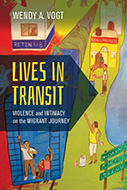Lives In Transit: Violence And Intimacy On The Migrant Journey

Author: Wendy A. Vogt
Publisher: Oakland: University of California Press, 2018. 266p.
Reviewer: Scott K. Turner | July 2019
This book is a timely exploration of Central American migration into Mexico and the United States. Wendy Vogt neutralizes any notion of politics at the outset of her discussion, and helps the reader to reflect on the issues and the humanity at stake. Her book is a journey through a complex social world that exists within “transit space.” In this space, migrants are commodities to be exploited in a vibrant economy of mobility. They are also prey to the violent trepidations of police, organized crime groups, and in some cases, local people. Yet, intimacy also blossoms in transit space. Vogt’s central argument is that violence and impunity are key processes in a multi-layered immigration industry from which a diverse range of actors will profit. As well, she points out the social forces that shape migration and influence the migrant experience.
Violence is why people migrate from Central America into Mexico and the United States. Migration is a response to violence! This assertion runs counter to U.S. media messaging which often reports that poverty and the potential of the American Dream drive migration. While economics does play a role, violence is the primary motivator. Vogt demonstrates that violence in this case is produced and reproduced by several factors, including civil wars, political turmoil, communism, and neo-liberal economic policies.
Neo-liberal policies constitute an important factor to consider in the migration formula. On the one hand, neo-liberal policies promote democracy and freedom for oppressed societies in Central America. Those policies have opened markets to global investment and promoted individualism. They have also, however, undermined wages, wiped out the safety net for workers and marginalized indigenous people. Over time, poverty, crime, and shifting power differentials led to the formation of police states. Caught between criminals and the police state, ordinary Central American citizens are marginalized, and migration seemingly represents their only escape.
Vogt reveals the risks associated with this escape, which are daunting. Contrary to some popular belief, the crossing from Central America into Mexico is fraught with danger. Migrants are not welcome, and Mexico is just the beginning of a long, dangerous journey through a gauntlet of crime. This is a journey that includes evading militarized Mexican police using zero tolerance policies that force migrants into the shadows where they become victimization opportunities for criminals.
Migrants avoid police checkpoints by taking alternate routes controlled by organized criminals. On these routes, they face horrific violence, such as rape, robbery, and in some cases murder. Rape is so common on the journey north that Central American woman take the “anti-Mexico” shot or insert an IUD to avoid pregnancy in preparation for the trek. Men and transgendered persons are sexually assaulted also, but women take the brunt of the pain.
There are safe houses along the route that offer a respite. Many of them are run by Catholic churches, while others are supported by non-profits. But safe houses come with risks as well. Criminals exploit the space around them to find a fresh supply of migrants to help fuel their enterprises. Safe houses are part of the complex web in which social interactions occur in transit space. They also represent a component of the economy of mobility that is supported by government, charities, and in some cases, local people.
Vogt is sympathetic to the plight of migrants. She tells their stories and suffers with them. Her focus is on understanding the social interactions and structures that bound the economy of mobility. To achieve that understanding, she lived at a safe house in Mexico for two years. There, she interacted with migrants and others operating in the economy of mobility. She conducted interviews, observed their daily lives, and experienced transit space firsthand. She also wrote about a forgotten group of migrants — the sick, injured, and disabled — detailing the emotional trauma that accompanies many on their route.
Trauma is an under reported threat to migrants. There is crime, but there is also death, injury and disease. Many migrants experience trauma from horrible accidents. Trainmen charge migrants illicit fares to ride in box cars or on train roofs, but some migrants fall or are thrown off and die. The “luckier” ones only lose limbs. Other migrants are stricken by disease. Far from home, without money to care for themselves, and nowhere to go, their hope is that charities and governments respond to their plight. This is another aspect of the economy of mobility that involves charities, hospitals, and local people. For the subgroup of migrants who suffer disease or injury, it can be the end of their journey and the beginning of an even more uncertain future. These are the kinds of issues that operate within transit space.
The author adds depth to her work by discussing yet another aspect of migration, which is the local community perspective. Some take it for granted that Central American migrants are welcomed by local people in Mexico, but Vogt dispels this myth. Many townspeople fear migrants, view them with contempt, and force them to traverse around rather than through their towns. Male migrants are perceived to be criminals, while females are treated like prostitutes. Some migrants are indeed criminals and do victimize Mexicans, and some migrant woman are recruited into the sex worker industry. These perceptions influence social interactions within the multi-layered economy of mobility. They also shape and reshape the lives of those living in Mexico.
Despite migration’s harshness, Vogt found that intimacy still exists in transit space. Humans are intimately connected, by nature, privately, personally, and in their sexual relationships. Migrants are no different, and many travel with their male or female partners. Some couples travel together with other couples to increase their safety. Together they experience personal intimacy. Private intimacy thrives as well. The author tells the stories of local people who offer migrants safety, sometimes allowing them to sleep on the floor in their homes. Others share food, comfort, and prayer. That intimacy also extends to the networks of shelters. Vogt refers to feminist scholarship to explain these interactions as “mothering.” The latter is a far cry from the violence that propels migration.
Migration truly is a complex web of social interactions and social forces as evidenced by Vogt’s data. I am left with the idea that there are many theatres of location through which the migrants pass, each connected by a trail that is fueled by violence on the one hand, and the impunity in committing violence on the other. It is an industry in which people are dehumanized. In the Central American theatre, migrants caught between the police state and criminal gangs flee. In the Mexican theatre, migrants caught between the militarized police and criminal gangs are targeted. All along the route a range of social interactions occur among people, communities, charitable organizations and the state. But Vogt finds something else also, and that is hope. Hope drives migration, perhaps dialectically with violence, but there is still hope!
Lives in Transit: Violence and Intimacy on the Migrant Journey is a timely and well-resourced perspective on a humanitarian and policy issue. For those seeking a deeper understanding of the issues beyond the rhetoric of mainstream media and politics, this book delivers. The author integrates critical, feminist, and opportunity perspectives to explain her observations and data. Itis likely that her findings will have a broader application to migration patterns in other regions of the world as well. I recommend the book as a primer to both the scholarly and police communities. It can also serve to inform upper level liberal arts, legal studies, political science, human services, sociology, and criminal justice students.
Scott K. Turner, West Virginia University at Parkersburg & West Virginia University


